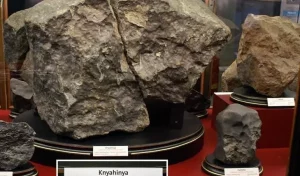

Надсилайте актуальну інформацію та отримуйте більше цільових клієнтів. Ми розмістимо ваш об’єкт у нашому каталозі та покажемо поруч із локаціями, а також у загальному каталозі, це безкоштовно!


On 09.06.1866, near the village of Knyaginya, Uzhgorod district, Transcarpathia, a unique event occurred – the fall of a huge meteorite. After a terrible explosion and stone rain, people, having recovered from fright, began to collect the debris. As luck would have it, no one was hurt by the rockfall. Superstitious peasants attributed miraculous powers to the mysterious black boulders. A trade in meteorite fragments began.

Content
 Place of fall Place of fall |
Knyahynya village, Uzhhorod district, Transcarpathian region |
 Coordinates of the fall Coordinates of the fall |
N49°00′18″ E22°33′24″ |
 Date of fall Date of fall |
June 9, 1866 at 5:00 p.m |
 Type Type |
Chondrite |
 Weight Weight |
Over 500 kg |
 Number of debris Number of debris |
Over 1200 |
 Distance from Vyshka Distance from Vyshka |
20 km |
 The road for The road for |
Car, on foot |
 Stay with a tent Stay with a tent |
No |
 Housing nearby Housing nearby |
Vyshka, Velykyi Bereznyi |
 Cafes and shops Cafes and shops |
Vyshka, Velykyi Bereznyi |
Special committees were set up to scientifically study the event, collecting and studying the meteorite fragments. In total, more than 1,000 pieces were found. The largest of them was found at a distance of 8 kilometres from the village of Knyahynya on Mount Stynka, in the Chorni Mlaki tract, by a simple peasant Vasyl Kryvianyk. He noticed a depression in the ground in the hayfield that he had never noticed before. After digging even deeper, he managed to find a large fragment of the Knyahynya meteorite weighing 279 kg 766 g. The forester of Velykyi Bereznyi, Andrii Pokornyi, managed to buy the find for a couple of oxen and then resell it to the Imperial Museum in Austria. Today, this fragment can be seen in the exhibition of the Vienna Natural History Museum.
The remaining fragments of the Knyaginya are in more than a hundred collections in many countries. The weight of all found pieces of the meteorite is almost half a tonne. This is the largest meteorite found in Europe.
The Transcarpathian Museum of Local Lore in Uzhhorod houses a fragment of a meteorite found in 1866 by Yuriy Volf. Yuri’s descendants, who kept the stone at home as a family heirloom, donated it to the museum in 1960. By its bright optical and powerful acoustic properties, number, shape and size of fragments, the Knyaginya meteorite is the most unique phenomenon of those times. It fell in the most favourable conditions – during the day, in clear sunny weather, in full view of tens of thousands of people. The phenomenon was immediately subjected to scientific research, which gave a strong impetus to the development of cosmogony. An official scientific commission visited the crash site on 12 July 1866.
Author of the article: Viktor Shatrov
Number of articles: 1100+
Knowledge of languages:: Ukrainian, English
Favourite quote: “Travelling – the only thing that makes you richer“
He was born and lived all his life in Uzhhorod. He graduated with a gold medal from Uzhhorod School No. 1 named after Taras Shevchenko (now Uzhhorod Lyceum named after Taras Shevchenko). He studied at the History Department of UzhNU, graduating with honours in 2009. He worked as a senior researcher at the Transcarpathian Museum of Folk Architecture and Life, a lecturer at the East European Slavic University.